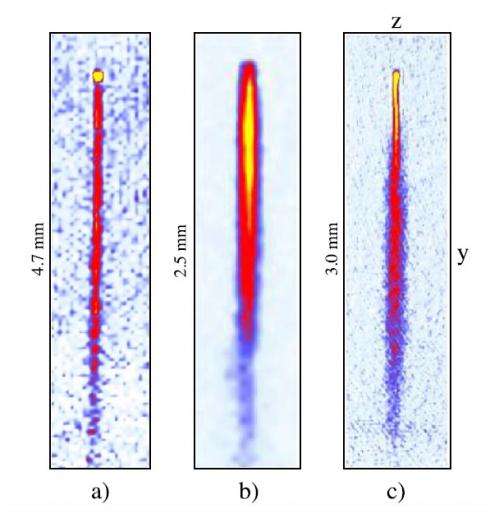The new atom laser technique can be used to create different types of lasers. These figures show the atom density distributions of (a) a well-collimated atom laser beam, (b) an ultra-high flux atom laser, and (c) an atom beam combining an atom laser and thermal emission. Credit: Bolpasi, et al. ©2014 IOP Publishing
(Phys.org) —In an atom laser, millions of individual atoms propagate through space with minimal spreading, just like photons propagate in a coherent photon laser beam. Although both types of lasers are similar, atom lasers are still in the early stages of research with much work to be done before they can be used for applications, which may include atom lithography, atom interferometry, and magnetometry (measuring magnetic fields).
A key factor for both types of lasers is their flux, which is the rate at which the atoms and photons are emitted. In current atom lasers, the flux is fundamentally limited by the same outcoupling process that is used to create the atom laser in the first place.
Now in a new study published in the New Journal of Physics, researchers from Greece and Singapore have demonstrated a novel, ultra-bright atom laser that overcomes this fundamental atom laser limit, achieving a flux of 107 atoms per second, which is seven times brighter than the brightest atom lasers to date. Using the same technique, the researchers also created an ultra-cold atom beam, which at just 200 nanoKelvin (nK) is two orders of magnitude colder than any atom beam reported to date.
As the researchers explain, atom lasers are usually made from clouds of atoms that are magnetically trapped and cooled to temperatures near absolute zero, the so-called Bose-Einstein condensates (BECs). A BEC is so cold that many of its atoms occupy their lowest energy states, or ground states. In this state the atoms lose their individual identity and form one single quantum state. These atoms join the other atoms in the ground states by bosonic stimulation, in a process that is very similar to the amplification process in optical lasers, in which large numbers of photons are created at the same frequency and same spatial distribution. In both cases, many particles occupy the same quantum level.
To get the BEC to emit a coherent beam of atoms, radio frequency (rf) fields are applied to the BEC to change the atoms' trapped states to "propagating" states. This process is called "outcoupling," and causes the atoms to accelerate out of the BEC and form the atom laser beam. The acceleration occurs due to a combination of factors, including gravity, magnetic forces, and interactions with other atoms.
In current atom lasers, the rf fields used in the outcoupling process are relatively weak. When increasing the rf field intensity bound states appear, and the output becomes irregular. As a result, the laser output can eventually shut off, creating a bottleneck to improving the flux.
To overcome this problem, the researchers in the new study used very strong rf fields, which rather than changing the atom's states deform the trapping potential. The strong rf fields form a trap with a controllable hole that causes the atoms to spill slowly out of a small opening in the bottom edge of the BEC. Whereas a weak rf field outcoupler cannot improve the flux past a certain point due to the formation of bound states, a strong rf field outcoupler can emit atoms from the BEC at an almost arbitrary rate, leading to a very high flux.
In experiments, the researchers achieved a flux of 7.4 x 107 atoms per second originating from only 9 x 104 atoms initially in the BEC. This flux is seven times larger than the previous maximum flux even though it uses less than half the number of atoms. The researchers predict that larger condensates combined with faster rf field pulses will further increase the flux by an order of magnitude.
In the second part of their study, the researchers used the strong rf field to create an atom beam that contains an atom laser and a thermal atom beam at the same time. This is the first time that this kind of hybrid atom beam has been demonstrated, and it is also the coldest atom beam ever reported. Even though the flux of the thermal atoms is low, the ultra-cold thermal beam may still be useful for high-resolution spectroscopy of ultra-cold collisions.
More information: V. Bolpasi, et al. "An ultra-bright atom laser." New Journal of Physics 16 (2014) 033036. DOI: 10.1088/1367-2630/16/3/033036
Journal information: New Journal of Physics
© 2014 Phys.org
























